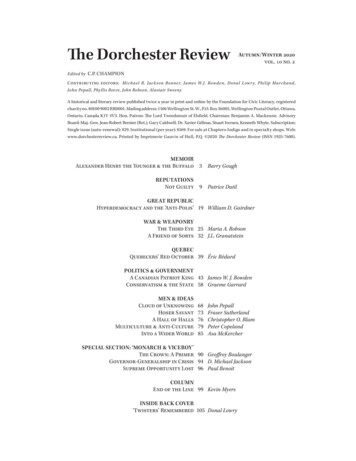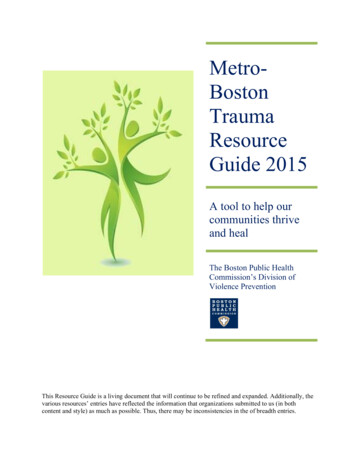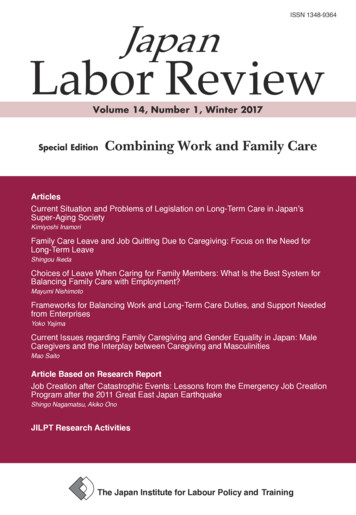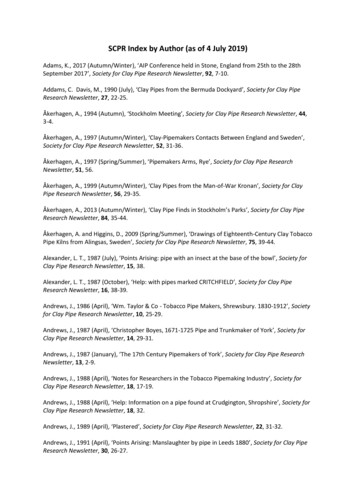
Transcription
The Dorchester ReviewAutumn/Winter 2020vol. 10 no. 2Edited by C.P. CHAMPIONContributing editors: Michael R . Jackson Bonner, James W.J. Bowden , Donal Lowr y, Philip Marchand ,John Pepall, Phyllis Reeve, John Robson, Alastair Sweeny.A historical and literary review published twice a year in print and online by the Foundation for Civic Literacy, registeredcharity no. 80100 9002 RR0001. Mailing address: 1106 Wellington St. W., P.O. Box 36005, Wellington Postal Outlet, Ottawa,Ontario, Canada K1Y 4V3. Hon. Patron: The Lord Tweedsmuir of Elsfield. Chairman: Benjamin A. Mackenzie. AdvisoryBoard: Maj.-Gen. Jean-Robert Bernier (Ret.), Gary Caldwell, Dr. Xavier Gélinas, Stuart Iversen, Kenneth Whyte. Subscription:Single issue (auto-renewal): 29. Institutional (per year): 169. For sale at Chapters-Indigo and in specialty shops. Web:www.dorchesterreview.ca. Printed by Imprimerie Gauvin of Hull, P.Q. 2020 The Dorchester Review (ISSN 1925-7600).MEMOIRAlexander Henry the Younger & the Buffalo 3 Barry GoughREPUTATIONSNot Guilty 9 Patrice DutilGREAT REPUBLICHyperdemocracy and the ‘Anti-Polis’ 19 William D. GairdnerWAR & WEAPONRYThe Third Eye 25 Maria A. RobsonA Friend of Sorts 32 J.L. GranatsteinQUEBECQuebecers’ Red October 39 Éric BédardPOLITICS & GOVERNMENTA Canadian Patriot King 43 James W. J. BowdenConservatism & the State 58 Graeme GarrardMEN & IDEASCloud of UnknowingHoser SavantA Hall of HallsMulticulture & Anti-CultureInto a Wider World6873767985John PepallFraser SutherlandChristopher O. BlumPeter CopelandAsa McKercherSPECIAL SECTION: ‘MONARCH & VICEROY’The Crown: A Primer 90 Geoffroy BoulangerGovernor-Generalship in Crisis 94 D. Michael JacksonSupreme Opportunity Lost 96 Paul BenoitCOLUMNEnd of the Line 99 Kevin MyersINSIDE BACK COVER‘Twisters’ Remembered 105 Donal Lowry
REPUTATIONSNot Guilty GHDWKV RYHU IRXU \HDUV KRZHYHU WUDJLF GR QRW FRQVWLWXWH nJHQRFLGHo E\ DQ\ UHDVRQDEOH VWDQGDUG t ZULWHV 3 75,&( '87,/The violent spectacle in Montreal in lateAugust was revolting enough; it becameall the more dispiriting when accounts revealed that the police had stood by watchingand waiting as demonstrators erected a tentaround the statue to conceal their hammers,ropes, and power-tools. After some time, theofficers kept watching while activists climbeddown and pulled the cables that brought SirJohn A. Macdonald’s likeness face down tothe pavement.One wonders if authorities would havebeen as generous with their time if any otherpublic monument in Montreal was similarlyassaulted. The helpless police stood there,looking on, clearly following orders fromon high, most likely from the Mayor, ValériePlante. The taxpayers will pay for the restoration. Ça va de soi !How did this handsome 125-year-old statue become the object of such unharnessedhatred? Even in the most damning days ofseparatism and nationalist historical revisionism, the monument that sits at the centre of Place du Canada has never been so savaged (the head did come off in the mid-1990s,Patrice Dutil is a professor in theDepartment of Politics at RyersonUniversity. He is the co-host of “Witness toYesterday,” the most popular podcast onCanadian history. His latest book is TheUnexpected Louis St-Laurent: Policiesand Politics for a Modern Canada (UBCPress). He has a Ph.D. from York University.but the statue was left intact).No one was detained or arrested for therecent vandalism, so the opportunity to question them on their motives has been lost.Not that it mattered, because the attack wasclearly part of a continental phenomenonin the pandemic summer of 2020. ThroughJune and July, cities in the United States wererocked by protests ignited by the gruesomekilling of an unarmed man by Minneapolispolice officers. In the South, a kulturkampf ofsorts played itself out with renewed demandsto remove civil war statues and monuments.The rationale ran something like this: thewhite supremacy purportedly displayed bypolice across the United States was empowered by the ongoing public display, high andmighty, of marbled, bronzed and stone representations of malignant white male figuresfrom history. If they came down, the reasoning ran, so would the legitimacy given to theongoing anti-black racism that has foreverblighted the American scene. At least thatwas what those who seem to thrive on stoking racial antagonism would have us believe.Dozens of generic monuments to Confederate soldiers were destroyed. The likesof Secessionist leaders such as Robert E. Leein Montgomery or the Albert Pike Memorialin Washington were also pulled down. Thenthe list of targeted monuments was extendedto explorers like Christopher Columbus (inRichmond, Va. and St. Paul, Minn.) and Juande Oñate (who led explorations in the South-Autumn/Winter 2020 The Dorchester Review9
Not Guiltywestern United States and became the firstan allegedly deeply-flawed and racist Canagovernor of what is today New Mexico). Evendian project. In order to put Macdonald backpriests were not spared: the monument totogether, not just as a piece of public art butthe Franciscan St. Junipero Serra, a Spanishas an important figure in Canada’s formativemissionary in California canonized by Popephases, a good first step would be to reviewFrancis in 2015, was also chained and thrownthese much-celebrated works.to the pavement.Daschuk’s relatively short work (187 pagThen, a few monuments erected to hees of text) had all the effect of a well-placedroes of democracy were removed. Figuresbomb when it came out in 2013 as it electriof George Washington werefied many in the historicaltorn down in Los Angeand Indigenous communityles and Portland. Also inwho were already startingForty-five deaths,Portland Thomas Jefferson,to make a fetish of Macanother slave-owner whodonald. Daschuk, then anhowever tragic,penned the more memorableassistant professor of Kinedo not constitutelines of the American Declasiology and Health Studiesration of Independence andat the University of Regina,‘genocide’ — andbecame a two-term presipublished the essence of hisfar more peopledent, was taken down. EvenPh.D. thesis in History relathose monuments to presidied in the factories tively late in life, after overdents who ardently foughttwenty years of work. Welland sweatshopsthe slave owners — Lincolnpromoted by its publisher,and Grant — have beenthe volume made a numberof Toronto andspoiled. A number of Teddyof dramatic arguments.*MontrealRoosevelt statues have alsocome down.Macdonald’s fate in Monhough much focusedtreal, but also in Kingston (where Queen’son understanding theUniversity removed his name from its lawevolution of indigenous health in Westernschool building) and in Toronto, may be seenCanada, Daschuk had a broader project inwithin this continental, and even global conmind that injected his work with a relevancetext of war against monuments of dead whitemost history books do not typically enjoy.males. In the small Ontario towns of PictonHe opened his introduction by contrastingand Baden, Macdonald has been put on trialCanada’s generally high ranking on theby sub-committees composed of know-nothUnited Nations Human Development Indexings determined to destroy his reputation inwith the conditions of Indigenous people inaddition to removing monuments.this country according to the measures of theThe soil for such desecrations was wellAssembly of First Nations. “Canadians havetilled for the past thirty years, both in whatcome to expect the highest-quality medicalhas been written by academics and in schoolcare as their national right,” he wrote, “butprograms (see my article in The Dorchesterindigenous people routinely suffer fromReview, Spring-Summer 2020) but sharpenedpoverty, violence, sickness and prematureby two particular publications. The first wasdeath” (xi). Although he then focuses onJames Daschuk’s Clearing the Plains: Disease,strictly healthcare matters, his obfuscatingPolitics of Starvation, and the Loss of Aborigipurpose was clear. Daschuk knew well thenal Life and the second, the Final Report of thedisparities in Canadian society and theCommission on Residential Schools headed byviolence known to many communities acrossSenator Murray Sinclair. Neither book wasparticularly revealing in terms of Canada’sfirst prime minister, but both of them have* The book was reviewed by Dr. Kenneth Coates inbeen used to demonize him as a symbol forThe Dorchester Review, Spring-Summer 2014.T10The Dorchester Review Autumn/Winter 2020
Not Guiltythe country that transcend race, and hesurely knows that there are also a number ofwealthy First Nations. But his purpose waspolemical: to create a false binary betweenthe Indigenous nations and the rest ofCanadians.Clearing the Plains was not really clearingnew territory. It was written almost entirelyby drawing on secondary sources, with a fewchapters making good use of the Hudson’sBay Company archives. The chapters thatfocus on Macdonald are mostly based on thepublished literature, with a few letters drawnfrom the Macdonald Papers and annual reports of the Department of Indian Affairs— Macdonald’s own department (which evidently lived up to his demands for accountability). Daschuk also used small collectionsof personal papers that had already been wellexplored.The claim that people starved on the prairies was hardly news. The book’s own jacketflap features an 1888 J.W. Bengough cartoonthat featured Macdonald (skinny and bignosed in his signature pose) chatting up a fatcat businessman. Standing behind them aredarkened and emaciated plains people. Tomake sure there was no confusion, Bengougheven added in the background of his scenea “Starved by a ‘Christian’ Gov’” placard. Infact, Bengough published many of these inGrip, his satirical weekly, and reading Canadians were well aware of the plight of theIndigenous people in the Northwest. In hisown day, Macdonald was chided (criticizedwould be too strong a word) for “starving”the people of the prairies. Most often he wascriticized (apt in this case) for doing too muchto help them.The Liberal Party was also well aware ofthe issue. The Alexander Mackenzie government (1873-1878) introduced and passedthe Indian Act in 1876, negotiated four “Numbered Treaties,” and was in office when theconsequences of the collapse of the buffalohunt began to be felt: Sitting Bull decided toleave the United States and move with 5,000people north of the border the follow ingyear. (Evidently, he had not heard of the devastating impact of the Indian Act.)The Liberals showed a callous disregardfor the indigenous people of the Northwest(their government did nothing to preventthe death of exposure and famine of 75 Indigenous people in the winter of 1878 — a tragicevent Daschuk overlooks because his prey isMacdonald). Under the leadership of EdwardBlake, the former Ontario premier who hadthe distinction of putting a bounty on LouisRiel’s head in 1870, the Liberals continuedtheir hypocrisy, haranguing the Macdonaldgovernment for spending too much moneyon the starved, and yet criticizing the government for not doing enough to avoid the insurrections of 1885.Issues related to Indigenous peoples wereraised fifteen times in the parliamentarysession that followed Macdonald’s return topower in the fall of 1878. The first item wasactually a government bill to amend theMounted Police Force Act in order to hire moreMétis and Indigenous peoples as interpretersand scouts because “they were accustomedto the ways and manners of the different Indian tribes, acquainted with their languageand movements, to act as scouts and dealwith the Indians. The government desiredthe aid of such a force which, moving amongthe different tribes, could learn their feelings,prejudices and complaints” (Hansard, Feb.28, 1879, p. 89). The Liberals were sceptical,but insisted that something be done to induce the Indigenous “to engage in industrialpursuits,” because “serious complicationswould arise when their present means of subsistence failed.” (p. 127)The Liberals noted in passing that past efforts “to elevate them [Indians] from barbarism” had failed and that unless the government “induced the Indians to remain fixedin the soil, end the tribal system and the influence of the chiefs as early as possible, andgave each individual a right to separate property in the soil and induced the Indians toengage in agricultural pursuits.” Otherwise,“serious troubles would be witnessed in theNorth West” (p. 128)Macdonald agreed. He bragged thatthe Canadian system was better than theAmerican way, because the Indigenous people“felt secure, and could easily be managed.”Autumn/Winter 2020 The Dorchester Review11
Not GuiltyCanada’s system was more honest — eventhough the Government “had defrauded theIndians time and again under the Liberals,giving them inferior grain and oxen.”Some might argue that the reality of thehardships on the prairies have just now been(re)discovered but that is not because historians did not cover it. George Stanley’s workson the Métis and the Prairie peoples datingback to the 1930s fully acknowledged thatpeople in the Northwest went hungry. Thefirst modern article to talk about Indigenousrepression on the prairies was published inthe Canadian Historical Review in 1982 andwas followed by dozens of articles and bookson various aspects of what was later calledcolonial genocide in Canada. Daschuk wasalso standing on the shoulders of writers likeSarah Carter and especially Maureen Lux,who have explored the world of disease onthe prairies without drawing any of the popular attention Clearing the Plains received,despite being just as readable and publiclyaccessible. Their claims, however, were morerestrained.The first six chapters (the first 100 pages)of Clearing the Plains focus on the life andhealth of plains people until Macdonald wasreturned to power in 1878. The final threechapters focus on the years to 1891, whenMacdonald died. The picture is not easy. Likeall Indigenous people from the North Pole tothe tips of Patagonia, Canada’s first peopleswere eventually subjected in various turnsto exposure to European viruses and bacteria. Those waves swept across the continent,often decimating substantial portions of thepopulation as trade routes expanded fromMi’kmaq territories to those of the Algonquins and Iroquois, the Anishinaabe, Cree,Sioux, and finally to the populations that dotted the Pacific Coast. (Tuberculosis finallycaught up with the Inuit after the polar invasion of Allied soldiers during the SecondWorld War.) The onslaught of TB in the west,Daschuk acknowledges, “caught the dominion government off guard” (p. xx) and, combined with episodes of famine, had a hard impact on the First Nations. It is not clear whatDaschuk believed the government of Canada12could do about TB, as adequate treatmentwas not discovered until 1943 and was firstsuccessfully tested in 1949. To Daschuk itdid not matter: Macdonald was guilty. Eventhough he acknowledges that various epidemics took the west by storm in the 1870sand 1880s to the point where the reserve population in Saskatchewan was at a “low-point”by the early 1890s, it was Macdonald’s fault.For him, disease was the “direct result of economic and cultural suppression that beganin the 1880s [and] haunts us still” (p. 186).Daschuk concluded his book with somecareful judgments. Over the broad sweep ofthe years covered in his volume, disease haddelivered debilitating blows time and againto the indigenous communities of the northwest, starting with those that had regularcontact with white traders. As Indigenouspeoples themselves started making use ofthe horses that had been imported into theterritory, bacteria and viruses spread furtherand faster. By the 1780s, the Cree who livedin the territory known to us as Saskatchewanwere so devastated by a smallpox outbreakthat “the existing band structure of the regionbuckled.” (p. 183) Daschuk concedes that “Inmany cases, the First Nations that enteredinto treaties with the crown were inheritorsof the plains rather than inhabitants sinceprehistoric times.”Daschuk also acknowledged that thenumbered treaties were signed in the 1870sbecause the Dominion of Canada and thoseliving on the prairie needed each other. Theformer sought stability and predictability.The Indigenous signers “saw treaties first andforemost as a bridge to a future without bison.” The Cree of Treaty 6 “astutely negotiatedfor medical aid and famine relief ” (p. 183). Infact, the treaty stipulated:That in the event hereafter of the Indians comprised within this treaty being overtaken by anypestilence, or by a general famine, the Queen,on being satisfied and certified thereof by HerIndian Agent or Agents, will grant to the Indians assistance of such character and to suchextent as Her Chief Superintendent of IndianAffairs shall deem necessary and sufficient toThe Dorchester Review Autumn/Winter 2020
Not Guiltya 16% increase. The next year, Macdonaldauthorized expenditures to 694,513, a 42%increase; in 1880-81, the funds amounted toDaschuk never actually writes that the 805,097, adding another 16%. By the timeMackenzie or Macdonald governments failedMacdonald called the next election, spendingin their commitments. “When the hunger beon Indian Affairs had grown to 1,183,414,gan,” he writes, “Canada simply did not havea 181% increase over what the Liberals hadthe people or the infrastructure to meet thespent. This was in the worst years of crisis foldemand for food.” But for Daschuk, thingslowing the collapse of the bison herd.took a turn for the worse when the ConserGenocide? Quite the contrary. Spending invatives took power in latethe Department of Indian Af1878 and lost patience withfairs increased far more thanthe few bands that were stillany other program categoryFor Professorcrisscrossing the West, lookand now constituted the thirding for the right place tolargest program expense ofDaschuk it wassettle.the Dominion, after publicunforgiveable thatFor Daschuk it was unforworks ( 2,893,513) and thegiveable that the MacdonaldMacdonald refused post office ( 1,980,567). (Thegovernment refused to chaselargest expense was subto chase down thedown the nomadic tribes andsidies to provinces, whichsupply them with rations.nomadic tribes and amounted to 3,530,999.)“The strategy was cruel butThe financial crash insupply them witheffective,” he concluded. Bythe fall of 1883 caused the1883, only a few hundred desgovernment to rethink itsrations, albeitperate holdouts were still notexpenses generally as the2,500 km awayon reserves and under thecountry slid into deprescontrol of the Departmentsion. But spending on Indianof Indian Affairs.” (p. 184)Affairs continued to galDaschuk does not explain how exactly thelop, reaching 1,201,301.32 by 1887. Falsely,Macdonald government could have ensuredthe Truth and Reconciliation Commissionthe delivery of fresh food to the populationsReport, vol. 1, p. 123, claims that the Indianin question. There were no railroads in theAffairs budget was slashed. Expenditures onwest and food storage was risky at best. TheIndian Affairs continued to increase by anonly way to survive was to grow it.average of 8% thereafter. “We are rigid, evenIn 1878, a government agent estimated thestingy,” Macdonald told the Liberals, “we canpopulation of Métis and other Indigenousnot allow them to starve and we cannot makepeoples at just under 27,000 people. To supplythem white men. All we can do is endeavourthem with meat, as Daschuk himself pointsto induce them to abandon their nomadicout (p. 107), Ottawa would have had to deliverhabits, and settle down, and cultivate the60 imperial tons of meat a day. This was fivesoil.” A negative interpretation need not bepounds of meat per day per person, rather aplaced on that statement, unless it is done inlot of food. Presumably, the agent either calorder to portray Macdonald in the worst posculated for spoilage or to compensate for thesible light.sheer inability to deliver during the winter.Daschuk, however, does not bother to examine the logistics of shipping food to theNorthwest or the unpredictability of the clin fact, Macdonald reacted strenuously tomate in the horrible early 1880s. The politithe plight of the Indigenous peoples. Incal and practical realities are not considered,the last year of its mandate (1877-78), theand the considerable efforts made in terms ofMackenzie administration spent 421,504 onprogram innovation (model farms, farming inIndian Affairs. Macdonald, arriving at midstructors and food rations) are ignored. Macfiscal year, boosted the spending to 489,327,relieve the Indians from the calamity that shallhave befallen them.IAutumn/Winter 2020 The Dorchester Review13
Not Guiltydonald’s government could have done nothingand spent nothing, in which case they wouldhave deserved the same accusation.I’ve done an inventory of deaths recordedin Daschuk’s book to see if the claim of aman-made genocide was substantiated. Indeed, most of his figures are conjectures andestimates — something he would readilyacknowledge. There is no real count in existence (certainly, the Indigenous communitiesdid not keep a reliable count, and neither didthe state for the most part though it is important to note that Macdonald ensured that hisdepartment submitted detailed reports everyyear). The grim reaper’s tally in Daschuk’sbook shows that 16,484 people died fromroughly the 1300s to 1896. (Yes, to cite “figures” from the 1300s in North America isspeculative indeed.)The point here is not to dispute the numbers presented in Clearing the Plains, but totest the author’s claim that the Macdonaldgovernment was genocidal. Daschuk specifically documents 1,126 deaths between 1879and 1883 but none afterwards. He includes151 deaths by starvation in North Dakota in1887 (the Americans did not distribute rations), but I am not considering those. By mycount, Daschuk points to 65 deaths possiblydue to starvation on the Canadian plainsfrom 1879 through to 1883. Twenty of thosedeaths are reported to have been the likelyproduct of poisoning in the Kanai (Blood) Reserve, so the number is probably closer to 45.Either way, as tragic as they were, 45 deathsover four years do not constitute genocide byany reasonable standard. Far more peoplelost their lives in the criminal sweatshopsand factories of Toronto and Montreal whenworkers (sometimes including children)toiled for over seventy hours a week. The Indians of the northwest who died succumbed todisease, most notably tuberculosis. For Macdonald’s contemporaries, this was normal:sad, but not unexpected.Daschuk never used the word “genocide”in his book, though he has lent his name tothe charge that Canada, specifically the Macdonald government, had been genocidal. Heused the expression in an article in the Globeand Mail (“When Canada Used Hunger to14Clear the West,” Jul. 19, 2013), concludingthat “As the skeletons in our collective closetare exposed to the light we will come tounderstand the uncomfortable truths thatmodern Canada is founded upon ethniccleansing and genocide and push our leaders and ourselves to make a nation we can beproud to call home.” Others picked up on theexpression, pointing to his book as evidencefor something he never claimed to have documented. Without fail, his book has beenunanimously celebrated in academic reviewsnot so much for its real breakthroughs butbecause it encapsulated the new sentimental political consensus that reigned on campuses. Irony of ironies, in 2014 it won boththe Macdonald Prize awarded by the Canadian Historical Association and the GovernorGeneral’s History Award.IIMacdonald was also accused ofspending too much money on the Indigenous peoples in the context of the residential schools, which were the focus of theTruth and Reconciliation Commission. Asthe TRC’s report coincided with the reception of Daschuk’s book, Macdonald suddenlybecame the lightning rod; the very embodiment of hostility to Indigenous communities.Commissioned by the Harper governmentin 2011, the inquiry chaired by Senator Sinclairreleased its report five years ago. The territoryof residential schools had already been tilledby a 481-page history and a separate 218page report commissioned by the RoyalCommission on Aboriginal People (1996) aswell as by J.R. Miller’s massive Shingwauk’sVision: A History of Native Residential Schools(1996). It was yet another very expensive prisede conscience designed to keep the light on apainful aspect of the Canadian experience.The sweep of Sinclair’s recommendationscaught public attention, but where the Commission had an undeniable impact was onMacdonald’s reputation, even though it hardly mentions his name. For the Sinclair group,the charge was that Macdonald was “presentat birth” and therefore guilty of nothing lessthan genocide or at least cultural genocide.The Dorchester Review Autumn/Winter 2020
Not GuiltyThe Commission did not mince words:Macdonald had gone to “war” against Indigenous families, the Report says, citing thewords he used in 1883 to explain the addedexpense of educating children away fromtheir communities:When the school is on the reserve the childlives with its parents, who are savages; he issurrounded by savages, and though he maylearn to read and write his habits, and trainingand mode of thought are Indian. He is simplya savage who can read and write. It has beenstrongly pressed on myself, as the head of theDepartment, that Indian children should bewithdrawn as much as possible from the parental influence, and the only way to do thatwould be to put them in central training industrial schools where they will acquire the habitsand modes of thought of white men. (p. 280)Tough talk, but what was actually done? Itis generally accepted that about 150,000 children attended the schools between the opening of the first in 1883 and 1996, when thelast one closed. It is also widely agreed thattwo-thirds of Indigenous school age childrennever attended them. These are estimates;there were times when a higher proportion ofkids attended and long periods when a muchsmaller number did. Most students onlystayed a short time because they were suchhostile, fetid places. The high point seemsto have in 1931, when 80 residential schoolswere in operation. The Canadian governmentstarted to trim the numbers to gain efficiencies. It was the St-Laurent government in theearly 1950s that sought to integrate, wherepossible, Indigenous students in publicschool boards run by the provinces.The Truth and Reconciliation Commissionproduced two volumes on the history ofthe Indigenous residential schools. The first,which goes to 1939, is a staggering 1,025 pages (vol. 2, which covers the years 1939-2000,weighs in at 859 pages). It does not carry thename of an author, co-author or even contributors. It barely pretends to be an academicdocument. The first two hundred pages aredevoted to residential schools before Canadawas created in 1867. The demonstration thatthere were all sorts of “residential schools”pre-dating Confederation should convincereaders that the problem can hardly be of Macdonald’s devising — but the commission doesnot recognize this fact. Obviously school wasuniversally held to be the best instrument toinculcate literacy, numeracy, and mainstreamvalues. This was known in the days of Charlemagne (9th century) and in the French, Spanish, English and Portuguese colonies that dotted the Americas from the early 16th century.Pretensions aside, the TRC’s report doesnot, technically or literally speaking, constitute “history.” The study makes no attempt toput things in perspective, to show how practices evolved or to compare the Canadianexperience with that of other countries. It is,rather, a rather blunt catalogue of findingstypical of Royal Commissions, providing along list of mini-studies of various phenomena with scarcely an academic veneer. Sixpages are devoted to school clothing from1867 to 1939, for example. Each chapter, inturn, lists the worst experiences recountedabout the schools. It is as if nothing good evercame out of them.Here is an example from p. 509, in about themiddle of the text. The study declares that:In the early 1930s, the federal government cutthe school per capita grant by 15%. In 1938,the Anglican Indian and Eskimo ResidentialSchool Commission pointed out that from1935 to 1938, the cost of flour had gone up43%; rolled oats, 8%; tea, 24%; and sugar, 6%.As funding declined and food costs went up,it was the students who paid the price — inmore ways than one. By the end of the 1930s,it was discovered that the cook at the Presbyterian school at Kenora was actually sellingbread to the students, at the rate of ten centsa loaf. When asked if the children got enoughto eat at meals, she responded, “Yes, but theywere always hungry.” The agent ordered an endto the practice. The fact that hungry studentswould be reduced to buying bread to supplement their meals in 1939 underscores the government’s failure to provide schools with theresources needed to feed students adequatelythroughout this period.Autumn/Winter 2020 The Dorchester Review15
Not Guiltyof radio, television and now of the internet, deNo explanation is offered as to why it tookserves much closer scrutiny.eight years for the the Anglican Indian andMacdonald in 1884 told the House ofEskimo Residential School Commission to reCommons that he had “every hope that theport the inflation. The text merely asserts thatinstitution will accomplish the purpose forit was the students “who paid the price.” It inwhich it has been established, namely, thevites multiple questions: to what degree wereeducation in the ordinary branches of learnthey paying for their food? Where did theseing and the instruction in industrial pursuitsimpoverished children get the money? Thenas well as the moral and social elevation ofwe find that one cook in Kenora was sellingthe Indian children who may be privilegedbread on the side. Was this one isolated incito attend it.”dent or was it widespread? Why did the agentend
The Dorchester Review Edited by C.P. CHAMPION Contributing editors: Michael R. Jackson Bonner, James W.J. Bowden, Donal Lowry, Philip Marchand, John Pepall, Phyllis Reeve, John Robson, Alastair Sweeny. A historical and literary review published twice a year in print and online by the Foundation for Civic Literacy, registered










